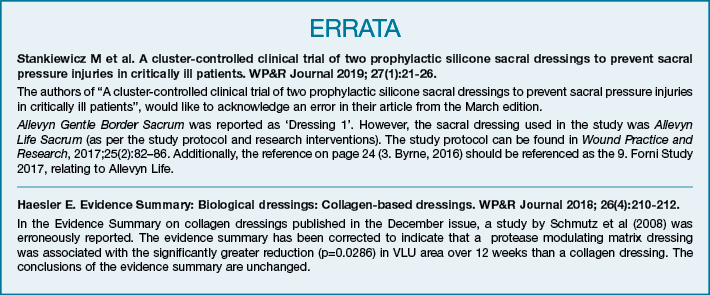Volume 27 Number 2
Wound research - the engine
Michael Woodward
For referencing Woodward M. Wound research — the engine. WP&R Journal 2019; 27(2):61.
DOI https://doi.org/10.33235/wpr.27.2.61
Our journal title says it all — to achieve the best outcomes for those with wounds, we need both meaningful research and effective practice. After the inaugural World Union of Wound Healing Societies meeting in Melbourne, 2000, it was decided that a large part of the substantial profits would be set aside to fund research on wounds and tissue repair. These Australian Wound Management Research grants (under various titles) have been awarded at most of the (now) Wounds Australia conferences, after applications are judged by members of the Research Portfolio. Priority areas include prevalence and cost-effectiveness research, impact on quality of life, risk factors for delayed healing, support surfaces and pressure injury prevention, compression therapy, dressings and innovative new therapies, and infection and symptom management. Grants are generally $5,000 or $10,000 and are expected to be utilised in 1–2 years, with the outcomes reported at the next national Wounds Australia conference and published in our journal.
Over the next two issues of this journal, articles from some of these funded research project groups will demonstrate not only the breadth of skills required for this work, but also the direct relevance of these studies to the practice of our clinicians (who are the largest proportion of those who delve into this journal). It starts in this issue with the University of Queensland’s scoping project on what has been already published on how outcomes are best measured and how research is best conducted. Too often, research has failed to meet these standards, and clinicians are left wondering what, if anything, to make of the findings. This is not the strong foundation required to begin to translate findings into practice. Australians, however, have an excellent track record for highest quality research and this scoping study will fuel that engine to further extend our horizons — and influence world practice and outcomes in wound management. Future publications from these funded projects will look at the risk factors that lead to wounds in diabetics becoming chronic, and whether the application of glyceryl trinitrate encourages wound healing. And there will be more.
Why is this so important? If we do not more fully adopt (and fund) a research culture, our understanding of tissue healing will remain incomplete. Also, outcomes will continue to vary widely, the specialty will remain ill-defined, government and other regulators will not subsidise products and technologies, and the outcomes for those with wounds will remain suboptimal. There HAS been a shift to such a culture, and whilst we still have a long way to go, we can even now hold our head high. Enjoy our journal.

Author(s)
Associate Professor Michael Woodward AM
Head – Aged Care Research, Director – Wound Clinic, Austin Health Heidelberg VIC



